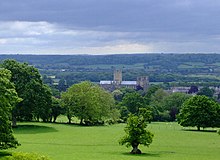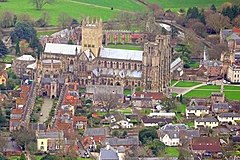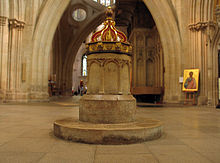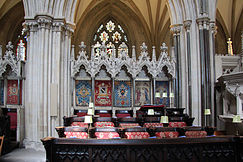Wells Cathedral is an Anglican cathedral in Wells, Somerset, England, dedicated to St Andrew the Apostle. It is the seat of the Bishop of Bath and Wells, whose cathedra it holds as mother church of the Diocese of Bath and Wells. Built as a Roman Catholic cathedral from around 1175 to replace an earlier church on the site since 705, it became an Anglican cathedral when King Henry VIII split from Rome. It is moderately sized for an English cathedral. Its broad west front and large central tower are dominant features. It has been called "unquestionably one of the most beautiful" and "most poetic" of English cathedrals.
Its Gothic architecture is mostly inspired from Early English style of the late 12th to early 13th centuries, lacking the Romanesque work that survives in many other cathedrals. Building began about 1175 at the east end with the choir. Historian John Harvey sees it as Europe's first truly Gothic structure, breaking the last co...Read more
Wells Cathedral is an Anglican cathedral in Wells, Somerset, England, dedicated to St Andrew the Apostle. It is the seat of the Bishop of Bath and Wells, whose cathedra it holds as mother church of the Diocese of Bath and Wells. Built as a Roman Catholic cathedral from around 1175 to replace an earlier church on the site since 705, it became an Anglican cathedral when King Henry VIII split from Rome. It is moderately sized for an English cathedral. Its broad west front and large central tower are dominant features. It has been called "unquestionably one of the most beautiful" and "most poetic" of English cathedrals.
Its Gothic architecture is mostly inspired from Early English style of the late 12th to early 13th centuries, lacking the Romanesque work that survives in many other cathedrals. Building began about 1175 at the east end with the choir. Historian John Harvey sees it as Europe's first truly Gothic structure, breaking the last constraints of Romanesque. The stonework of its pointed arcades and fluted piers bears pronounced mouldings and carved capitals in a foliate, "stiff-leaf" style. Its Early English front with 300 sculpted figures is seen as a "supreme triumph of the combined plastic arts in England". The east end retains much ancient stained glass. Unlike many cathedrals of monastic foundation, Wells has many surviving secular buildings linked to its chapter of secular canons, including the Bishop's Palace and the 15th-century residential Vicars' Close. It is a Grade I listed building.
The earliest remains of a building on the site are of a late-Roman mausoleum, identified during excavations in 1980.[1][2] An abbey church was built in Wells in 705 by Aldhelm, first bishop of the newly established Diocese of Sherborne during the reign of King Ine of Wessex.[3][4] It was dedicated to St Andrew and stood at the site of the cathedral's cloisters, where some excavated remains can be seen. The font in the cathedral's south transept is from this church and is the oldest part of the present building.[5][6] In 766 Cynewulf, King of Wessex, signed a charter endowing the church with eleven hides of land.[a][8][9] In 909 the seat of the diocese was moved from Sherborne to Wells.[1]
The first bishop of Wells was Athelm (909), who crowned King Æthelstan. Athelm and his nephew Dunstan both became Archbishops of Canterbury.[3] During this period a choir of boys was established to sing the liturgy. Wells Cathedral School, which was established to educate these choirboys, dates its foundation to this point.[10] There is, however, some controversy over this. Following the Norman Conquest, John de Villula moved the seat of the bishop from Wells to Bath in 1090.[11] The church at Wells, no longer a cathedral, had a college of secular clergy.[11]
Seat of the bishopThe cathedral is thought to have been conceived and commenced in about 1175 by Reginald Fitz Jocelin, who died in 1191.[12][13][14] Although it is clear from its size that from the outset, the church was planned to be the cathedral of the diocese,[11] the seat of the bishop moved between Wells and the abbeys of Glastonbury and Bath, before settling at Wells. In 1197 Reginald's successor, Savaric FitzGeldewin, with the approval of Pope Celestine III, officially moved his seat to Glastonbury Abbey. The title of Bishop of Bath and Glastonbury was used until the Glastonbury claim was abandoned in 1219.[15]
Savaric's successor, Jocelin of Wells, again moved the bishop's seat to Bath Abbey, with the title Bishop of Bath. Jocelin was a brother of Hugh (II) of Lincoln[16] and was present at the signing of the Magna Carta. Jocelin continued the building campaign begun by Reginald and was responsible for the Bishop's Palace, the choristers' school, a grammar school, a hospital for travellers and a chapel. He also had a manor house built at Wookey, near Wells.[17] Jocelin saw the church dedicated in 1239 but, despite much lobbying of the Pope by Jocelin's representatives in Rome, did not live to see cathedral status granted. The delay may have been a result of inaction by Pandulf Verraccio, a Roman ecclesiastical politician, papal legate to England and Bishop of Norwich, who was asked by the Pope to investigate the situation but did not respond.[18] Jocelin died at Wells on 19 November 1242 and was buried in the choir of the cathedral;[16][17][19] the memorial brass on his tomb is one of the earliest brasses in England.[17] Following his death the monks of Bath unsuccessfully attempted to regain authority over Wells.[20]
In 1245 the ongoing dispute over the title of the bishop was resolved by a ruling of Pope Innocent IV, who established the title as the "Bishop of Bath and Wells", which it has remained until this day, with Wells as the principal seat of the bishop.[21] Since the 11th century the church has had a chapter of secular clergy, like the cathedrals of Chichester, Hereford, Lincoln and York. The chapter was endowed with 22 prebends (lands from which finance was drawn) and a provost to manage them. On acquiring cathedral status, in common with other such cathedrals, it had four chief clergy, the dean, precentor, chancellor and sacristan, who were responsible for the spiritual and material care of the cathedral.[22]



The building programme, begun by Reginald Fitz Jocelin, Bishop in the 12th century, continued under Jocelin of Wells, who was a canon from 1200, then bishop from 1206. Adam Locke was master mason from about 1192 until 1230.[23] It was designed in the new style with pointed arches, later known as Gothic, which was introduced at about the same time at Canterbury Cathedral.[24] Work was halted between 1209 and 1213 when King John was excommunicated and Jocelin was in exile,[25] but the main parts of the church were complete by the time of the dedication by Jocelin in 1239.[11]
By the time the cathedral, including the chapter house, was finished in 1306,[26] it was already too small for the developing liturgy, and unable to accommodate increasingly grand processions of clergy. John Droxford initiated another phase of building under master mason Thomas of Whitney,[26] during which the central tower was heightened and an eight-sided Lady chapel was added at the east end by 1326.[27] Ralph of Shrewsbury followed, continuing the eastward extension of the choir and retrochoir beyond. He oversaw the building of Vicars' Close and the Vicars' Hall, to give the men who were employed to sing in the choir a secure place to live and dine, away from the town and its temptations.[28] He had an uneasy relationship with the citizens of Wells, partly because of his imposition of taxes,[28] and he surrounded his palace with crenellated walls, a moat and a drawbridge.[29][30]
John Harewell raised money for the completion of the west front by William Wynford, who was appointed as master mason in 1365. One of the foremost master masons of his time, Wynford worked for the king at Windsor, Winchester Cathedral and New College, Oxford.[31] At Wells, he designed the western towers of which north-west was not built until the following century.[32] In the 14th century, the central piers of the crossing were found to be sinking under the weight of the crossing tower which had been damaged by an earthquake in the previous century.[33] Strainer arches, sometimes described as scissor arches, were inserted by master mason William Joy to brace and stabilise the piers as a unit.[33][34]
Tudors and Civil WarBy the reign of Henry VII the cathedral was complete, appearing much as it does today (though the fittings have changed). From 1508 to 1546, the eminent Italian humanist scholar Polydore Vergil was active as the chapter's representative in London. He donated a set of hangings for the choir of the cathedral.[35][36] While Wells survived the Dissolution of the Monasteries better than the cathedrals of monastic foundation, the abolition of chantries in 1547 resulted in a reduction in its income. Medieval brasses were sold, and a pulpit was placed in the nave for the first time.[37] Between 1551 and 1568, in two periods as dean, William Turner established a herb garden, which was recreated between 2003 and 2010.[38][39]
Elizabeth I gave the chapter and the Vicars Choral a new charter in 1591, creating a new governing body, consisting of a dean and eight residentiary canons with control over the church estates and authority over its affairs, but no longer entitled to elect the dean (that entitlement thenceforward belonged ultimately to the Crown).[40] The stability brought by the new charter ended with the onset of the Civil War and the execution of Charles I. Local fighting damaged the cathedral's stonework, furniture and windows. The dean, Walter Raleigh, a nephew of the explorer Walter Raleigh, was placed under house arrest after the fall of Bridgwater to the Parliamentarians in 1645, first in the rectory at Chedzoy and then in the deanery at Wells.[41] His jailor, the shoe maker and city constable, David Barrett, caught him writing a letter to his wife. When he refused to surrender it, Barrett ran him through with a sword and he died six weeks later, on 10 October 1646.[42] He was buried in an unmarked grave in the choir before the dean's stall.[43] During the Commonwealth of England under Oliver Cromwell no dean was appointed and the cathedral fell into disrepair. The bishop went into retirement and some of the clerics were reduced to performing menial tasks.[44]
1660–1800In 1661, after Charles II was restored to the throne, Robert Creighton, the king's chaplain in exile, was appointed dean and was bishop for two years before his death in 1672.[45] His brass lectern, given in thanksgiving, can be seen in the cathedral. He donated the nave's great west window at a cost of £140. Following Creighton's appointment as bishop, the post of dean went to Ralph Bathurst, who had been chaplain to the king, president of Trinity College, Oxford and fellow of the Royal Society.[46] During Bathurst's long tenure the cathedral was restored, but in the Monmouth Rebellion of 1685, Puritan soldiers damaged the west front, tore lead from the roof to make bullets, broke the windows, smashed the organ and furnishings, and for a time stabled their horses in the nave.[47]
Restoration began again under Thomas Ken who was appointed by the Crown in 1685 and served until 1691. He was one of seven bishops imprisoned for refusing to sign King James II's "Declaration of Indulgence", which would have enabled Catholics to resume positions of political power, but popular support led to their acquittal. Ken refused to take the oath of allegiance to William III and Mary II because James II had not abdicated and with others, known as the Nonjurors, was put out of office.[48] His successor, Richard Kidder, was killed in the Great Storm of 1703 when two chimney stacks on the palace fell on him and his wife, while they were asleep in bed.[49][50]




By the middle of the 19th century, a major restoration programme was needed. Under Dean Goodenough, the monuments were moved to the cloisters and the remaining medieval paint and whitewash removed in an operation known as "the great scrape".[51] Anthony Salvin took charge of the extensive restoration of the choir. Wooden galleries installed in the 16th century were removed and the stalls were given stone canopies and placed further back within the line of the arcade. The medieval stone pulpitum screen was extended in the centre to support a new organ.[52]
In 1933 the Friends of Wells Cathedral were formed to support the cathedral's chapter in the maintenance of the fabric, life and work of the cathedral.[53] The late 20th century saw an extensive restoration programme, particularly of the west front.[54][55] The stained glass is currently under restoration, with a programme underway to conserve the large 14th-century Jesse Tree window at the eastern terminal of the choir.[56][57]
In January 2014, as part of the Bath film festival, the cathedral hosted a special screening of Martin Scorsese's The Last Temptation of Christ. This provoked some controversy, but the church defended its decision to allow the screening.[58][59]
In 2021, a contemporary sculpture by Anthony Gormley was unveiled on a temporary plinth outside the cathedral.[60]
Cite error: There are <ref group=lower-alpha> tags or {{efn}} templates on this page, but the references will not show without a {{reflist|group=lower-alpha}} template or {{notelist}} template (see the help page).


































Add new comment